This is the third installment of Project 24, a series that documents the lives and work of millennial artists based in New York City. As a collection, these portraits explore how the latest generation of contemporary artists operate in their relative intersections, navigate New York's dynamic art scene and adopt hybrid forms of visual expression. For other artists on our radar be sure to check out HuffPost Arts.
![2014-11-07-AdamPortraitUpload.jpg]()
It's a little past 3AM on a Thursday morning.
We're sitting across each other in his sparsely furnished South Slope studio. Around us: quasi-floor-to-ceiling paintings on gessoed wooden panels -- two unfinished, all looming overhead like a congregation of sacred idols. It's been years since he's touched them.
But according to Echahly, these works haven't been put out to pasture just yet. "They're not done," he explains, "I'll get around to finishing them."
Until then, he's on the frontier of a relatively new method of painting, and he's using an apparatus that he characterizes as an extension of his mind. With deep fondness (and an equally deep voice), he tells me its utility translates his ideas with the speed and precision that his imagination demands. By the same token, he's uncovering inventive ways to manipulate the medium, subsequently pushing its boundaries.
Behold: symbiosis at its finest.
But before the big reveal, let's circle back to the start.
![2014-11-07-EchahlyOldStudioUpload.jpg]()
Echahly in his South Slope studio
We first meet in Chelsea.
The neighborhood is familiar stomping grounds for the artist, who spent his formative years growing up in downtown Manhattan -- a detail he reveals as we walk the length of the pier leading down to the Jane Hotel. Inside: a hidden lounge-cafe complete with posh, low-seated sofas and mismatched chandeliers has just opened its doors.
Our conversation eventually turns to his occasional tendency to drop off the grid -- a habit he's working to correct. Even those close under the vest are often left in the dark for periods of time. "I'll just disappear for a while. I don't answer texts, phone calls, or Facebook messages. It's sad." For an artist who values connectivity, it's a consequence that he's actively taking steps to prevent.
But the question stands: what does he do during these spells?
I ask him. He's hesitant to answer.
![2014-11-07-AdamStudioUpload.jpg]()
Echahly at the Jane Hotel
Then again, he's also hesitant to share anything on his social feed or to unveil his work. It's a reservation that stems from a deep respect for everyone's (yes, everyone's) time and opinion. "I try to be responsible with what I put out in the world," he admits. It's a value system that makes him responsible in all the ways that count.
At length, with intervals of silence between us, his answer arrives. He recalls late nights ambling around the deserted warehouse district of South Slope; working odd jobs; and long, insightful conversations with Ali, a writer and his primary confidant. Together, they've cultivated a delicate and private space where honesty is the only criterion for peer review. Their conversations have and continue to hold import in much of Echahly's artistic growth.
![2014-11-07-AdamAllieUpload.jpg]()
Echahly and Ali
We wrap up at the Jane and make moves for Brooklyn.
The subject of his undergraduate experience comes up during the commute. From his first year at the Art Institute of Chicago, to his dalliance with the School of Visual Arts, and now, his enrollment at Parsons, Echahly relays his reasons for embarking on an art-school blitz.
Echahly sees formal instruction in the arts as an increasingly commodified product. Schools devise distinct identities and package them for mass consumption. Though it's a sentiment that arguably applies to higher education at large, its presence pervades the realm of visual art in a very specific way. "You can tell when someone studied at Chicago, or Cooper. They're stamped with this specific aesthetic." They're brands that Echahly would rather do without -- exclusively, at least.
Guided by a curatorial approach, Echahly is interested in the creation of images using disparate sources and influences -- a process he describes as kin to "completing a jigsaw puzzle." At galleries, on walks, during train rides, Echahly's eyes are scanning around the clock for a leg or an eye or a pattern that fits into his paintings. And once he finds it, the real work begins.
![2014-11-07-AdamSculptureUpload.jpg]()
Echahly with previous works (painting and furniture/sculpture)
Collage-work was Echahly's natural starting point, but once he discovered the magic of Photoshop and digital painting, he's been predisposed to eschew traditional mediums.
Well-versed as he is with acrylics and oils, their limitations render them unsuitable vehicles for his vision. Take, for example, the time-consuming process of mixing colors or stretching a canvas. As far as Echahly sees it, he'd rather be experimenting with entire compositions on Photoshop in the time it would've taken him to batter up some alizarin-red. So these days, Echahly's been spending the crux of his time working in a portable studio: his MacBook (or any computer for that matter).
Here, in this virtual studio, the artist maximizes on time and space. Within seconds, every color, texture, and scale is at the artist's disposal, and the impulse to generate hundreds of pieces is readily supported by a 16" x 9" storage unit.
It's undoubtedly a radical statement, challenging popular notions of an artist's studio space. But in a market where even the cheapest brands of supplies and materials are expensive commodities, it's a protest to the financial inaccessibility of painting that ought to be expressed more often.
Besides, the appeal of making art on a Brooklyn rooftop doesn't hurt.
![2014-11-07-AdamStudioSpaceUpload.jpg]()
(Top) Echahly at work (Bottom) Echahly's studio
Technology's incorporation into the broader language of visual art, while still largely undefined, is a transition that Echahly's interested in exploring -- digital painting being the overlap of his choice. In 100, even 200 layers, Echahly creates virtual compositions that allow him to trace his growth and return to earlier stages -- both of which are privileges that physical painting can't afford its artists.
![2014-11-07-Thinking.jpg]()
Echahly, Adam. "Thinking". 2014. 79" x 100". New York.
Echahly coats his virtual canvases meticulously with the knowledge that each layer is inherently unhidden. Both the experience of creation and the reception of the created piece is altered by this intrinsic transparency.
![2014-11-07-p4ym.jpg]()
Echahly, Adam. "Lay Back". 2014. 64" x 84". New York.
The resulting paintings speak for themselves.
![2014-11-07-leaveoutthetitle.jpg]()
Echahly, Adam. 2012. New York.
It's a little after 3AM and we're sitting in his South Slope studio.
Offhandedly, eyes fixed on his Macbook, he invites me for a walk, which for him is a surefire source of inspiration. Come Indian summer or polar vortex, Echahly will walk undeterred. But with a number of plans laying in wait beyond graduation, these invitations will be all the rarer.
Among them (and what he hopes will happen in the immediate future): a trip to Morocco, his homeland, as well as excursions to peripheral states where Echahly intends to exchange ideas with the locals. At once an immersion in his heritage and an exposure to new methods of artistic thought, the trip is sure to yield him powerful material to integrate into his own work. For an artist who readily embraces the experiences and opinions of others, what he'll learn from the region is certain to leave an indelible mark.
But until then he'll be in New York, and if you happen to be in his neck of the woods, feel free to reach out to him: He'll invite you for a walk.
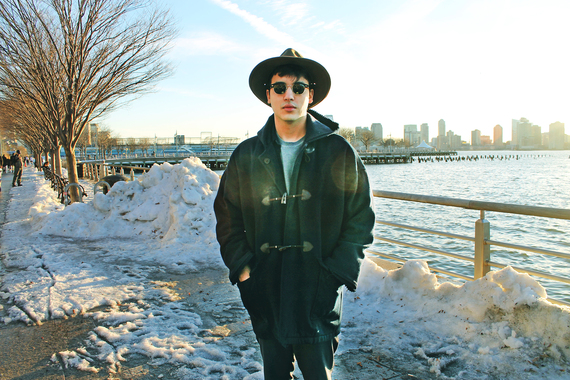
It's a little past 3AM on a Thursday morning.
We're sitting across each other in his sparsely furnished South Slope studio. Around us: quasi-floor-to-ceiling paintings on gessoed wooden panels -- two unfinished, all looming overhead like a congregation of sacred idols. It's been years since he's touched them.
But according to Echahly, these works haven't been put out to pasture just yet. "They're not done," he explains, "I'll get around to finishing them."
Until then, he's on the frontier of a relatively new method of painting, and he's using an apparatus that he characterizes as an extension of his mind. With deep fondness (and an equally deep voice), he tells me its utility translates his ideas with the speed and precision that his imagination demands. By the same token, he's uncovering inventive ways to manipulate the medium, subsequently pushing its boundaries.
Behold: symbiosis at its finest.
But before the big reveal, let's circle back to the start.

Echahly in his South Slope studio
We first meet in Chelsea.
The neighborhood is familiar stomping grounds for the artist, who spent his formative years growing up in downtown Manhattan -- a detail he reveals as we walk the length of the pier leading down to the Jane Hotel. Inside: a hidden lounge-cafe complete with posh, low-seated sofas and mismatched chandeliers has just opened its doors.
Our conversation eventually turns to his occasional tendency to drop off the grid -- a habit he's working to correct. Even those close under the vest are often left in the dark for periods of time. "I'll just disappear for a while. I don't answer texts, phone calls, or Facebook messages. It's sad." For an artist who values connectivity, it's a consequence that he's actively taking steps to prevent.
But the question stands: what does he do during these spells?
I ask him. He's hesitant to answer.
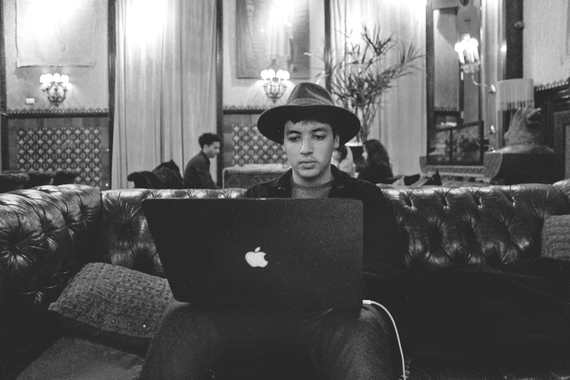
Echahly at the Jane Hotel
Then again, he's also hesitant to share anything on his social feed or to unveil his work. It's a reservation that stems from a deep respect for everyone's (yes, everyone's) time and opinion. "I try to be responsible with what I put out in the world," he admits. It's a value system that makes him responsible in all the ways that count.
At length, with intervals of silence between us, his answer arrives. He recalls late nights ambling around the deserted warehouse district of South Slope; working odd jobs; and long, insightful conversations with Ali, a writer and his primary confidant. Together, they've cultivated a delicate and private space where honesty is the only criterion for peer review. Their conversations have and continue to hold import in much of Echahly's artistic growth.
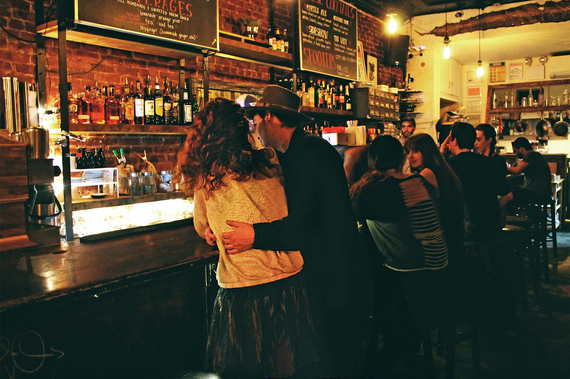
Echahly and Ali
We wrap up at the Jane and make moves for Brooklyn.
The subject of his undergraduate experience comes up during the commute. From his first year at the Art Institute of Chicago, to his dalliance with the School of Visual Arts, and now, his enrollment at Parsons, Echahly relays his reasons for embarking on an art-school blitz.
Echahly sees formal instruction in the arts as an increasingly commodified product. Schools devise distinct identities and package them for mass consumption. Though it's a sentiment that arguably applies to higher education at large, its presence pervades the realm of visual art in a very specific way. "You can tell when someone studied at Chicago, or Cooper. They're stamped with this specific aesthetic." They're brands that Echahly would rather do without -- exclusively, at least.
Guided by a curatorial approach, Echahly is interested in the creation of images using disparate sources and influences -- a process he describes as kin to "completing a jigsaw puzzle." At galleries, on walks, during train rides, Echahly's eyes are scanning around the clock for a leg or an eye or a pattern that fits into his paintings. And once he finds it, the real work begins.
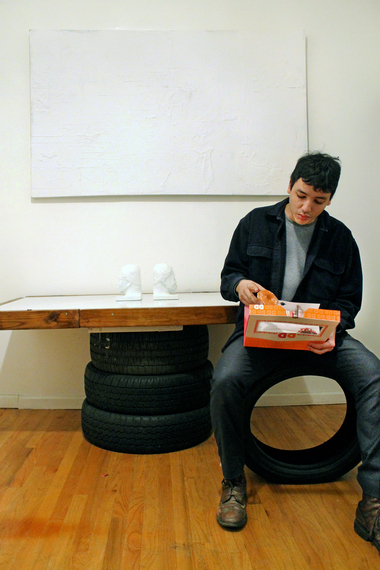
Echahly with previous works (painting and furniture/sculpture)
Collage-work was Echahly's natural starting point, but once he discovered the magic of Photoshop and digital painting, he's been predisposed to eschew traditional mediums.
Well-versed as he is with acrylics and oils, their limitations render them unsuitable vehicles for his vision. Take, for example, the time-consuming process of mixing colors or stretching a canvas. As far as Echahly sees it, he'd rather be experimenting with entire compositions on Photoshop in the time it would've taken him to batter up some alizarin-red. So these days, Echahly's been spending the crux of his time working in a portable studio: his MacBook (or any computer for that matter).
Here, in this virtual studio, the artist maximizes on time and space. Within seconds, every color, texture, and scale is at the artist's disposal, and the impulse to generate hundreds of pieces is readily supported by a 16" x 9" storage unit.
It's undoubtedly a radical statement, challenging popular notions of an artist's studio space. But in a market where even the cheapest brands of supplies and materials are expensive commodities, it's a protest to the financial inaccessibility of painting that ought to be expressed more often.
Besides, the appeal of making art on a Brooklyn rooftop doesn't hurt.
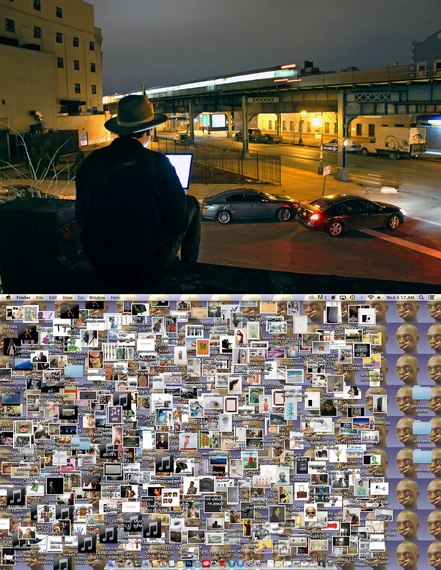
(Top) Echahly at work (Bottom) Echahly's studio
Technology's incorporation into the broader language of visual art, while still largely undefined, is a transition that Echahly's interested in exploring -- digital painting being the overlap of his choice. In 100, even 200 layers, Echahly creates virtual compositions that allow him to trace his growth and return to earlier stages -- both of which are privileges that physical painting can't afford its artists.

Echahly, Adam. "Thinking". 2014. 79" x 100". New York.
Echahly coats his virtual canvases meticulously with the knowledge that each layer is inherently unhidden. Both the experience of creation and the reception of the created piece is altered by this intrinsic transparency.

Echahly, Adam. "Lay Back". 2014. 64" x 84". New York.
The resulting paintings speak for themselves.

Echahly, Adam. 2012. New York.
It's a little after 3AM and we're sitting in his South Slope studio.
Offhandedly, eyes fixed on his Macbook, he invites me for a walk, which for him is a surefire source of inspiration. Come Indian summer or polar vortex, Echahly will walk undeterred. But with a number of plans laying in wait beyond graduation, these invitations will be all the rarer.
Among them (and what he hopes will happen in the immediate future): a trip to Morocco, his homeland, as well as excursions to peripheral states where Echahly intends to exchange ideas with the locals. At once an immersion in his heritage and an exposure to new methods of artistic thought, the trip is sure to yield him powerful material to integrate into his own work. For an artist who readily embraces the experiences and opinions of others, what he'll learn from the region is certain to leave an indelible mark.
But until then he'll be in New York, and if you happen to be in his neck of the woods, feel free to reach out to him: He'll invite you for a walk.